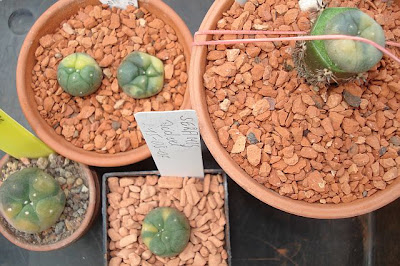Dirk is a lucky man. Anyway, judged by the quality of his collection of crested and variegated cacti, he has to be ;-) I think you’ll agree after seeing the pictures that Dirk has been kind enough to let me share in this post.

Ariocarpus retusus var. elongata crest
I’m particularly fond of this photo of a cristate Ariocarpus retusus, resembling a plant creature one would not be too surprised to encounter in a Tolkien novel.
Dirk is living in Belgium and knows a commercial cactus grower in Holland who lets him pick and choose interesting seedlings when he’s visiting (to stock up on Harrisia for grafting). On this account Dirk has got quite a collection of variegated Lophophora.

Lophophora williamsii f. variegata
I especially like the pastel pink, yellow, and green colors of the above plant – it’s almost a wine gum look-alike ;-) But the rest of the collection is definitely also nice.

Lophophora williamsii f. variegata grafted on Harrisia

Lophophora williamsii f. variegata 'Zebra'

Collection of variegated Lophophora williamsii
Dirk also has plants showing dichotomous branching like these beautifully symmetric two-headed Obregonia denegrii and Lophophora williamsii plants.

Two-headed Obregonia denegrii

Collection of two-headed Lophophora williamsii
Last I heard from Dirk he had just returned from a visit to the 2007 ELK. He had tried to obtain a cristate Lophophora – unfortunately without any luck. You can see more of Dirk’s amazing collection at his cactelders web site.
I hope you enjoyed this featured collection - if you have pictures or information you would like to share, you can drop me a mail at “lophophora [dot] blog [at] gmail [dot] com”.
Monday, September 24, 2007
Dirk’s collection of cristate and variegated cacti
Sunday, September 23, 2007
In search of Echinocereus reichenbachii in Wichita Mountains Wildlife Refuge
I recently revisited Oklahoma City. Having heard that Echinocereus reichenbachii is abundant in the millions in Oklahoma, I decided to see if I could find some of these fascinating plants in habitat where they occur in many stem forms and spine colors. E. reichenbachii grows in several of the state parks in western Oklahoma, but after a bit of research I decided on visiting the Wichita Mountains Wildlife Refuge. The refuge is within easy driving distance from OKC (head southwest on highway 44 for an hour or so, then take the Medicine Park exit just north of Lawton) and apart from cacti it also boasts a rare remnant mixed grass prairie, an island where the natural grasslands escaped destruction thanks to the granite outcrops rendering the land impossible to plow.

A cluster of Echinocereus reichenbachii var. albispinus
All the Echinocereus plants I found were of the variety Echinocereus reichenbachii var. albispinus (or Echinocereus baileyi if you consider it a full species). It seems like the plants prefer to grow in fissures in the granitic rock, especially if moss is also growing in the fissures.

E. reichenbachii var. albispinus growing in moss
The pictured plants are growing in the open prairie grasslands south-east of Mount Scott. It’s quite amazing that most of the plants seem undamaged by the grazing herds of bison and longhorn; I would expect such a large animal could trample an Echinocereus underfoot without even noticing it, but that doesn’t seem to be the case.

Grazing bison
I also saw a few Opuntia plants – probably O. phaeacantha – with beautiful carmine-red fruits. The pictured plant is growing on the southern bank of Quanah Parker Lake; named for the Quanah Parker of Native American Church fame.

Fruiting Opuntia sp. (O. phaeacantha?)
The Wichita Mountains Wildlife Refuge is a very interesting place to visit and I wish I had had more time (unfortunately I had to deal with delayed baggage, limiting the visit to half a day). It comes highly recommended if you are looking for Echinocereus reichenbachii var. albispinus (= Echinocereus baileyi) or bison ;-)
You can find more photos from my visit at http://public.fotki.com/WichitaMountainsWR/.
All Time Most Popular Posts
-
Lophophora williamsii (peyote) populations have diminished in large areas of South Texas where peyoteros harvest the cactus for ceremonial ...
-
On various occasions I've been asked what growing media I'm using for my cactus plants. I don't have a set soil mix recipe as su...
-
Below is a list of retailers/nurseries selling cactus seed and plants. I've only listed vendors I've done business with. If you ar...
-
Most cacti are easily grown from seed - and with a little patience and care they can be grown into beautiful plants. Lophophora williamsi...
-
In last month’s post on the troubled Texan peyoteros I referred to Anderson’s article on the peyote situation in Texas. Given the importanc...
-
Yet another slightly off topic and probably not entirely politically correct post, but I couldn’t help noticing the similarity of my monstr...
-
Flowering stand of San Pedro cacti (Trichocereus pachanoi) To me the main draw of the San Pedro cactus ( Trichocereus pachanoi (syn. Ech...
-
In the June 2008 issue of the Cactus & Co magazine Jaroslav Šnicer, Jaroslav Bohata, and Vojtěch Myšák described a new Lophophora spec...
-
There seems to be an increased focus on the alarming Texas peyote situation. A couple of weeks ago the Houston Press published a mournful, i...
-
I spent two weeks working in Delhi, India during January. I had one weekend off and had planned to spend it in Delhi at my own leisure, but ...


















